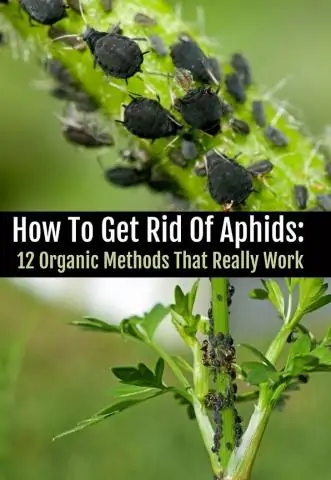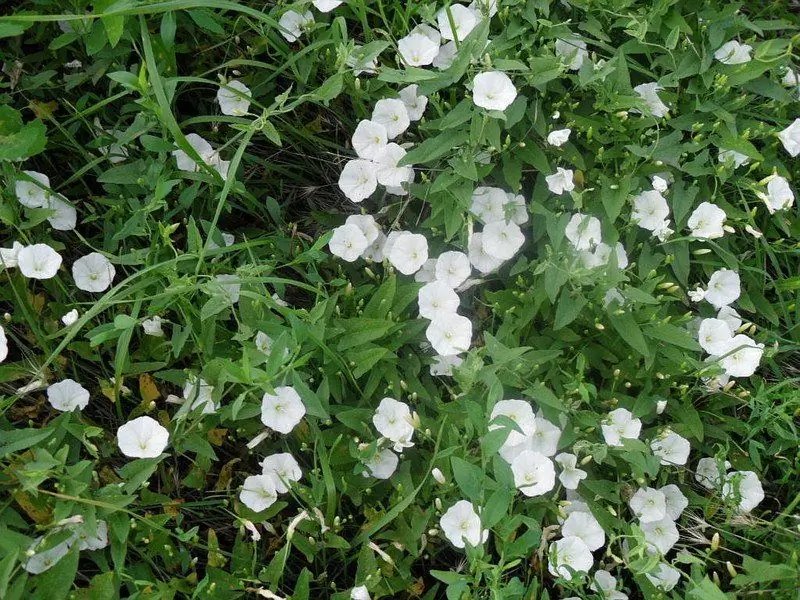
Table of contents:
- Author Bailey Albertson [email protected].
- Public 2023-12-17 12:53.
- Last modified 2025-01-23 12:41.
Aphids in the garden: methods of control and prevention

Every gardener loves his plants, cares for, cherishes and as a reward for his work and invested soul expects to get a rich harvest. And how sad it can be to find that there are still people who want not only to reduce it, but also to harm the plants. Aphids are one of the most famous and common pests in our gardens. Fortunately, there are many ways to deal with this intruder.
Content
-
1 What a pest of aphids
1.1 Species of aphids
-
2 Methods of dealing with aphids
-
2.1 Chemicals
2.1.1 Table: effective modern insecticides
-
2.2 Folk recipes
2.2.1 Video: aphid super remedy
-
-
3 Prevention of aphids in the garden
- 3.1 Use of plants
- 3.2 Insects and birds that feed on aphids
- 3.3 Maintenance work in the garden
- 4 Features of the fight against aphids in greenhouses
- 5 Reviews
What a pest of aphids
Aphids are a small insect from the order of Hemiptera. In nature, there are about 4 thousand species of this insect. All types of aphids feed on plant juices and many of them are pests. The most dangerous cause diseases in plants, spreading various viruses.
Despite its small size (about 2 mm), the damage to aphids is very noticeable. With the help of a special proboscis, pests pierce the surface of leaves and shoots and draw out plant sap. The plant weakens and stops growing, and in cases of a viral disease, gall-like formations appear on the stems.

Aphids settle on young shoots and leaves and feed on plant juices
Usually, an insect colony settles on the young juicy tops of a wide variety of crops. Translucent white, gray, green or black pests are disguised as a host plant.
The life cycle begins with aphid larvae that hatch from eggs in the spring. Like parents, they feed on the juice of young stems and leaves of garden crops and after a short interval breed wingless females. In a month, one female gives birth to thousands of insects. When the stalks of plants become woody, winged females emerge. These individuals choose another suitable plant species for themselves and move to it. Aphids reproduce very intensively and over the summer there are about a dozen generations of females of both species - with and without wings. In autumn, winged males appear, which settle on the previous plant. There the females lay their eggs in the winter.
Aphid species
There are many varieties of aphids and they differ not only in appearance and distribution area, but also in preferred cultures. The most common:
- Mealy aphid is a small yellowish-milky parasite with an oval body, covered with a mealy bloom. The pest infects plants in rooms and greenhouses, as well as grapes and citrus fruits. Mealy aphids can be recognized by the white bloom on the leaves, which is the mycelium of parasitic fungi. The shoots of the affected plant are deformed, the buds fall off. If urgent action is not taken, the plant dies.
-
Cherry aphids are black and most often settle on cherries and sweet cherries. The pest becomes more active with the arrival of spring and, before the lignification of the shoots, manages to cause irreparable harm. Plants are noticeably depressed, their growth is inhibited and the development of flower buds is disturbed, the fruits become smaller and lose their taste. After such an invasion, the trees weaken and winter badly.

Cherry aphid Cherry aphid, rapidly spreading, completely covers the young tops of cherry and sweet cherry
-
Potato aphid is a fairly large pest of red or green color. The body of the insect reaches 4 mm in length and has a tail and antennae. This aphid tolerates low temperatures and depletes tomatoes, potatoes and cabbage. In winter, potato aphids often settle on indoor flowers.

Potato aphid Potato aphid infects the leaves of many vegetable crops
-
Cabbage aphid is a gray-green insect. The ovoid body does not exceed 2.5 mm in length and is covered with a gray waxy coating. Aphid eggs hibernate in unharvested cabbage leaves. In spring, the colony settles on young plants, deforming the leaves. The development of cabbage is delayed, the heads of cabbage are poorly formed.

Cabbage aphid If urgent measures are not taken, cabbage aphid colonies can leave the gardener without a crop.
-
The green apple aphid parasitizes the apple tree, pear, peach, quince and other fruit trees of the Rosaceae family. The larvae are born during the opening of the buds, and by the time of flowering, adult insects appear. Seedlings affected by green aphids do not grow well and hardly form fruit buds. Mature trees set small fruits with poor taste. Damaged plants overwinter poorly and are often susceptible to various diseases and attacks of other pests.

Green apple aphid Green apple aphid not only damages plants, but can also cause serious diseases.
-
The blood apple aphid lives in the south of Russia and in Central Asia. Wingless females are brown-red, densely pubescent. The length of the insect is about 2 mm. If you crush such aphids, a liquid will appear that resembles blood in color. Blood aphid larvae can damage not only leaves and bark, but also the roots of trees. Growing rapidly, aphid colonies cover the tops of young trees. The optimal conditions for the vital activity of parasites are warm air (20 ° C) and humidity. If frosts occur in the habitat in winter, then the blood aphid dies.

Blood apple aphid Bloody apple aphids are common in warm climates.
Often ants assist in the dispersal of aphids. They feed on the sweet secretions of aphids - honeydew. In order to have enough syrup, the insects decided to tame the "supplier". And this is not fiction - the ants really drag the aphids along the young shoots, take care of them, and protect them from predatory insects. For the winter, hard workers drag their nurses and eggs to anthills, where they calmly survive even the most severe frosts.

Aphids and ant - a clear example of mutually beneficial partnerships
Aphid control methods
Aphid extermination is not difficult. The insect dies from ordinary soap solution or the use of folk remedies. In case of severe damage to large areas, insecticides can be used.
Chemicals
Today the market offers a wide range of different insecticides. According to the methods of exposure, they are all divided into three groups:
- intestinal action - the sprayed agent enters the digestive tract of the insect and kills it;
- contact action - destroys the pest, entering the body through the chitinous cover;
- systemic action - it penetrates the plant and kills insects that feed on the juice of leaves and shoots. The effect of such insecticides is the longest - from 2 to 4 weeks, moreover, the effectiveness of the drugs does not decrease after rains.
The new generation drugs are less toxic (in contrast to their predecessors) and do not have a detrimental effect on the environment. Despite this, each of them contains a poisonous substance, therefore, when working with solutions, it is necessary to observe safety measures - work with gloves and a respirator, do not eat or smoke during processing.

When working with insecticides, protection is never superfluous
Table: effective modern insecticides
| Drug name | Efficiency | Toxicity | Soil pollution degree | Price | Protective period |
| Fitoverm | The drug is of intestinal action, effective against aphids, various ticks, Colorado potato beetle, thrips, etc. | Biological product (class 3 of hazard - a substance of moderate hazard). | Does not pollute the soil, does not accumulate in fruits and plants. | 10 ml - 65 rubles. | 1-3 weeks in the absence of rain. |
| Corado | Systemic agent of contact-intestinal action against aphids and many other parasites. | Low toxicity for humans, but dangerous for bees and fish, can cause poisoning in birds and domestic animals. | 10 ml - 76 rubles. | 20-30 days. | |
| Fufanon | 5 ml - 10 rubles. | 5-10 days. | |||
| Commander | 10 ml - 74 rubles. | 2-4 weeks. | |||
| Aktara | Low toxic to humans, animals, birds, fish and soil inhabitants, but very dangerous to bees. | 4 g - 110 rubles. | 2.5 months. |
Folk recipes
Many gardeners choose natural farming for themselves and refuse to use chemical remedies on their plots. In the fight against aphids and other pests, they use all kinds of folk remedies. The same measures are resorted to in case of a sudden attack of a pest, when only a few days remain before harvesting and it is impossible to treat plants with chemicals.
The most famous folk remedies for fighting aphids:
- Water. If aphids have settled on apple trees, cherries or other plants with tough shoots, then you can wash off the insects with a stream of water from a hose. Once on the ground, the pests will not be able to return on their own. True, ants can help them with this.
-
Soap solutions. A piece of tar or laundry soap must be grated, diluted in a bucket of water and treated with the affected plants from a spray bottle. To enhance the action, add 1 tbsp to the bucket. l. soda ash. Instead of tar soap, you can use a special green soap, which is sold in the gardening departments.

Green soap You can fight aphids with green soap
-
Birch tar solution. Dissolve 10-15 g of tar in 10 liters of water and add 50 g of grated soap. Mix everything thoroughly and spray the affected plants. Birch tar not only destroys aphids and other insects, but also successfully fights some diseases. The strong smell of the product scares off mice and moles.

Birch tar Birch tar fights aphids and scares away rodents
- Ash infusion. 2 tbsp. wood or grass ash should be dissolved in a bucket of water and kept for 12 hours. Spray the plants with the resulting infusion. It is advisable to add a soapy solution for adhesion. This is one of the most effective methods of dealing with aphids.
- Tobacco infusion. Crushed tobacco leaves or shag must be poured with boiling water and kept for a day. For 5 liters of boiling water, you will need 1 tbsp. dried raw materials. Strain the infusion and treat damaged plants. Due to the high concentration, spraying should be carried out no later than 10 days before harvest.
-
Citrus broth. 2 tbsp. soak dried crushed peels of lemons or oranges in 1 liter of water for a day. Boil the zest for 10-15 minutes, squeeze and pour the solution into a bucket of water. The addition of a small amount of liquid soap will increase the spray effect.

Orange peel Citrus peels do not need to be thrown away, they will come in handy in the fight against insect pests
-
Alcohol tinctures. Alcohol or vodka can be used neat or infused with herbs:
- pour 2 tbsp into a bucket of water. l. ammonia and the same amount of liquid soap. Spray the plants twice with an interval of 2 weeks;
- dilute vodka or regular alcohol by half with water and spray the plants. The method is quite effective, but not cheap, therefore it is used when aphid spread is small.
-
Herbal infusions. Infusions based on hot pepper, garlic and horseradish do well with aphid colonies. Wormwood, chamomile, dandelion and other garden plants and weeds are equally effective in fighting parasites. It is advisable to add green or liquid soap to all solutions:
- to obtain a pepper remedy, 2 pods of hot pepper are crushed and poured into 1 liter of boiling water. After cooling, the infusion is filtered;
- the leaves and roots of horseradish are crushed, the container is filled with the mixture by 1/3 and boiled water is added. After a day, filter;
- knead the head of garlic and pour 1 liter of boiling water. The cooled solution is filtered and 2 tbsp. l. vegetable oil;
- 0.5 kg of freshly cut chamomile, wormwood, dandelions or celandine are poured into 10 liters of water for 4 hours, then the infusion is filtered.
Video: super remedy for aphids
Prevention of aphids in the garden
The appearance of a pest is always easier to prevent than to wage a tireless fight against multiplying colonies. Strong, healthy plants easily deal with insects, and the pests themselves bypass them.
Use of plants
When planning planting, experienced gardeners do not forget about plants that repel or attract aphids.
Near crops susceptible to the attack of this insect are planted:
- sagebrush;
- celandine;
- chamomile;
- marigold;
- coriander;
- basil;
- yarrow;
- tansy;
- garlic;
- onion.

Marigolds can be planted next to a rose suffering from periodic attacks of aphids - they will scare away the pest
Plants that attract aphids are planted away from the main plantings to distract the pest from the cultivated plantings. Aphid bait can be:
- cosmeya;
- petunia;
- nasturtium;
- tuberous begonia;
- mallow;
- poppy.
Insects and birds that feed on aphids
In the prevention of the appearance of aphids and the fight against the pest, natural predators - insects and birds - provide invaluable help. The larvae and adults of the ladybug, some species of wasps, predatory bugs, earwigs, wasps, hoverflies and lacewings eat a malicious pest.

Ladybugs are the most common predator insects
To attract beneficial insects to the garden, you need to try to plant each free area with spicy fragrant herbs or nettles. Parsley, coriander, basil, tarragon planted in tree trunks will also scare away harmful insects with their aroma.
Small birds (sparrows, tits, bloodworms, linnet, warblers, robins) destroy not only aphids, but also many other harmful insects

Tits will help cleanse the garden of aphids without the use of special products
The gardener's task is to attract volunteer helpers to the garden. It is not difficult to do this, it is enough to take care of the access of birds to water, hang birdhouses, and in winter - feeders.
Maintenance work in the garden
In the fall, it is necessary to clear the site from fallen leaves and weeds, and trees - from diseased branches and overgrowth, in which pests often hibernate. When preparing the garden for winter, it is advisable to whitewash the tree trunks - this measure will prevent the laying of aphid eggs and destroy pathogenic fungal spores.

Whitewashing tree trunks and skeletal branches is a necessary preventive measure against aphids
In the spring and summer, it is necessary to carry out work to contain ants. Do not destroy them completely, as in a rainy summer they can become the only pollinators in the garden. The ground around trees and plants prone to aphid infestation should be sprinkled with ash around the perimeter - ants cannot overcome such a barrier. Repeat the procedure after rain.
If aphid infestations are regular and very annoying, then in the spring, trees and shrubs are sprayed with insecticides or folk remedies on the blossoming buds. Trunks, branches and soil under the plants also need to be processed.
In the summer, during the appearance of the pest, if there is no hope for the help of birds and predatory insects, the plants are treated with any folk remedy or insecticide.
Proper agricultural practices will help to avoid aphid infestation or significantly reduce the damage caused by the pest. Necessary care includes:
- rejuvenation of berry bushes with the removal of old and diseased branches;
- proper feeding, including, in addition to the usual nitrogen, phosphorus and potassium, other necessary trace elements;
- feeding plants with ash - the potassium contained in it strengthens the cell walls of shoots and leaves. Do not bite through a strong leaf plate;
- maintaining optimal soil acidity - plants do not assimilate trace elements on acidified or alkalized soils;
- replenishment of calcium consumed by plants - on peat and humus soils, you need to bring fluff for digging, and on sandy loam and clay soils - dolomite flour.
Features of the fight against aphids in greenhouses
It is easier to spot a pest in a confined, enclosed space than in a garden. Regularly inspecting the plantings, you can avoid the appearance of a colony. It is enough to use one of the means or wash the plants with water when the first pests are found.
When aphids appear in greenhouses, spraying with the above insecticides or herbal infusions is used. But there are other interesting ways, like fumigation. A small fire of chips is made in a metal bucket or any other suitable container. As soon as the flame flares up, a handful of tobacco dust (sold in gardening stores) is thrown into the fire. White smoke immediately starts pouring from the fire. Close all windows and doors and leave the greenhouse for several hours. After the smoke clears, there are no aphids or other harmful insects in the room.

Tobacco or sulfur fumigations make it easier to control aphids in the greenhouse
In my garden, I try to do without the use of pesticides. Aphids sometimes appear on currants, but the habit of walking around the garden every day and gazing intently at the flower leaves helps to notice something wrong in time. This small fry settles on young tops, which I immediately pinch off and burn. Those tops that cannot be pinched off, I rinse with plain water from a hose. I did not observe the reappearance of pests, although there are no other ants in my garden - both large and small, and red and black. Once I tried to fight them, but as soon as I managed to bring them out in one place, they immediately appeared in another. I do not notice any particular harm from them, so I resigned myself to the presence. Several years ago I planted Jerusalem artichoke - an earthen pear - along the fence. The strip of friendly shoots 25 meters long did not please for long. As soon as the plants rose to a meter height, I noticed aphids on the tops (all at once). Jerusalem artichoke is not a currant, you cannot pour it out of a hose, so I decided to try wormwood - our area is rich in several varieties of this amazing plant at once. I made an infusion and was already preparing to spray, but noticed a ladybug on the top of the plant. The hand did not rise to pour bitterness on such a cutie, went on. These divine predators sat on almost every top of Jerusalem artichoke, and I decided to postpone the treatment for a couple of days. Needless to say, after this time, there were no aphids on my earthen pear, and there were no traces of their presence either. By the way, I haven't seen ants near this aphid, maybe they find something tastier.so I decided to try wormwood - our area is rich in several varieties of this amazing plant. I made an infusion and was already preparing to spray, but noticed a ladybug on the top of the plant. The hand did not rise to pour bitterness on such a cutie, went on. These divine predators sat on almost every top of Jerusalem artichoke, and I decided to postpone the treatment for a couple of days. Needless to say, after this time, there were no aphids on my earthen pear, and there were no traces of their presence either. By the way, I haven't seen ants near this aphid, maybe they find something tastier.so I decided to try wormwood - our area is rich in several varieties of this amazing plant. I made an infusion and was already preparing to spray, but noticed a ladybug on the top of the plant. The hand did not rise to pour bitterness on such a cutie, went on. These divine predators sat on almost every top of Jerusalem artichoke, and I decided to postpone the treatment for a couple of days. Needless to say, after this time, there were no aphids on my earthen pear, and there were no traces of their presence either. By the way, I haven't seen ants near this aphid, maybe they find something tastier. These divine predators sat on almost every top of Jerusalem artichoke, and I decided to postpone the treatment for a couple of days. Needless to say, after this time, there were no aphids on my earthen pear, and there were no traces of their presence either. By the way, I haven't seen ants near this aphid, maybe they find something tastier. These divine predators sat on almost every top of Jerusalem artichoke, and I decided to postpone the treatment for a couple of days. Needless to say, after this time, there were no aphids on my earthen pear, and there were no traces of their presence either. By the way, I haven't seen ants near this aphid, maybe they find something tastier.
Reviews
Aphids are not as scary as they seem. With a huge amount of chemical pesticides and folk recipes, you can often do without all this. If you properly care for the garden, follow all agricultural techniques, attract beneficial insects and birds to the garden, spraying is most likely not needed. And if the invasion got out of control, it is better to start the fight with the use of folk remedies.
Recommended:
How To Get Rid Of Urine Stains And Odors On The Couch: Effective Cleaning Methods + Photos And Videos

How to get rid of the urine smell on the couch. Methods for removing stubborn stains and animal marks. Effective recipes and precautions
How To Get Rid Of Rats In A Private House, Chicken Coop, Apartment And Other Premises - Using Various Methods To Get Rid Of Rodents

Reasons for the appearance of rats in the house. What methods, means to use in the fight against rats in various residential and non-residential premises. Preventive actions. Video
How To Quickly Get Rid Of Hiccups At Home, Including After Alcohol: Effective Methods

What is hiccups and why do people get it. Effective methods for getting rid of hiccups. How they work. What are the unusual ways to deal with hiccups
How To Permanently Get Rid Of The Field Bindweed In The Garden: Methods And Reviews

What is the field bindweed, why is it very difficult to get rid of it. What are the ways for this, what do experienced gardeners say about them
5 Things I Will Get Rid Of Before The New Year To Bring Happiness And Wealth Into The House, As Well As Get Rid Of Negativity

According to the old tradition, before the New Year, I get rid of 5 unnecessary things in order to let the positive energy of happiness and prosperity into my life
